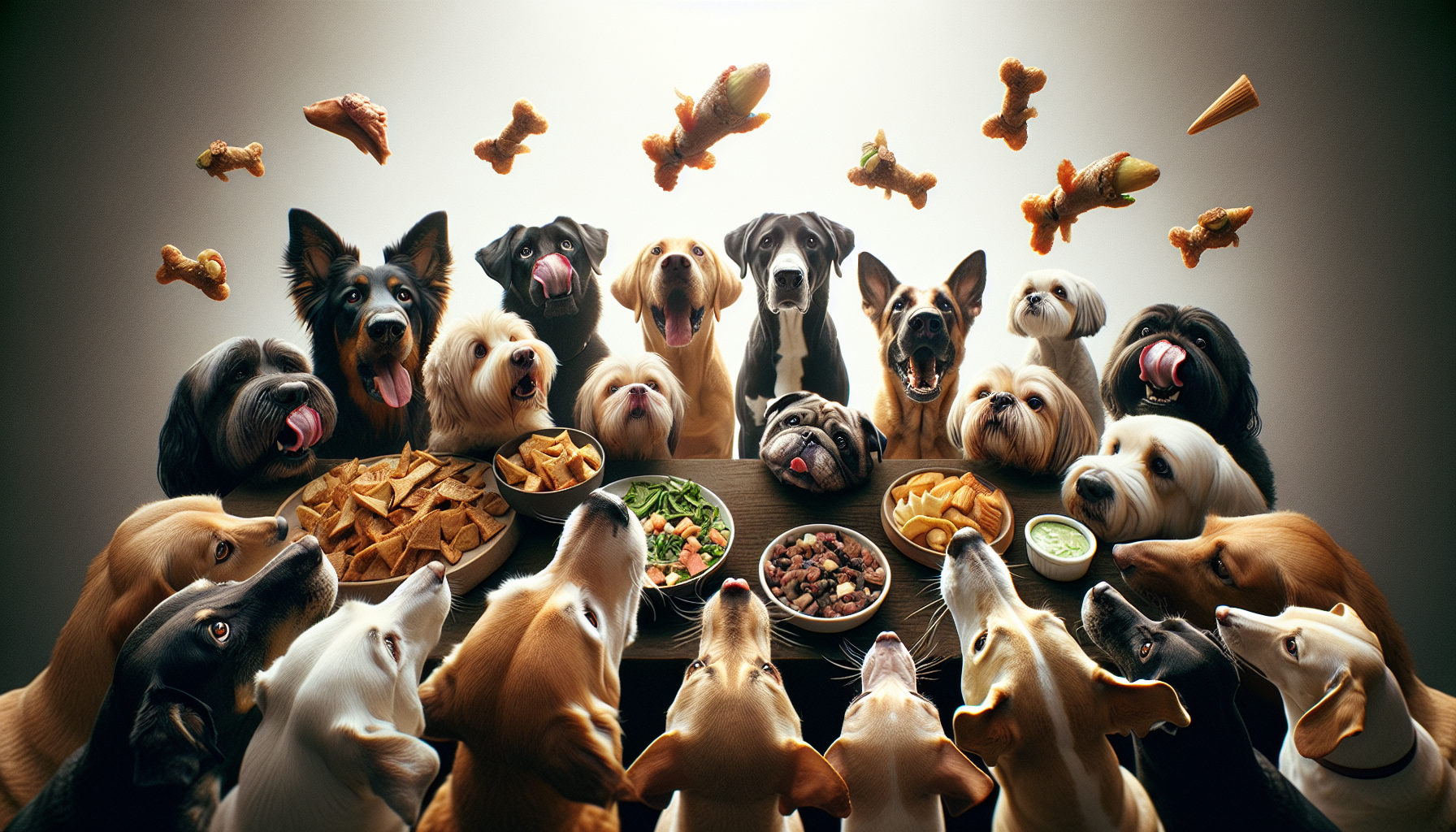Contents
What scents are most enticing to dogs?
As a dog owner, you may have noticed that your furry friend has an incredible sense of smell. In fact, a dog’s sense of smell is 10,000 to 100,000 times more powerful than that of humans. They have over 300 million olfactory receptors, compared to our mere 6 million. This amazing sense of smell allows dogs to detect certain scents that we may not even notice. But what scents are most enticing to dogs? Let’s explore some of their favorites.
1. Meat
It’s no secret that dogs love the smell of meat. The aroma of freshly cooked chicken, beef, or even bacon can make their mouths water. Dogs are carnivores by nature, and their keen sense of smell is particularly attuned to the scent of meat. This is why many dog treats and food brands use real meat flavors to entice our furry friends.
2. Scent of other dogs
Dogs are social creatures, and they communicate through various scents. The scent of other dogs can be highly enticing to them. When they encounter the scent of another dog, they can gather valuable information about their age, sex, health, and even reproductive status. This is why dogs often sniff each other when they meet.
3. Familiar scents
Dogs have an incredible memory for scents. They can remember and recognize the scent of their owners, favorite toys, or even familiar places. These familiar scents provide them comfort and a sense of security. So, if you notice your dog getting excited when they catch a familiar scent, it’s because it brings back pleasant memories and associations.
4. Medical scents
Dogs have been trained for years to detect certain medical conditions, such as cancer, diabetes, or seizures. They can even be trained to detect a drop in blood sugar levels or changes in the body odor of someone with certain health conditions. These scents are not only intriguing to dogs but can also be life-saving for humans.
5. Earthy scents
Dogs have an affinity for earthy scents like grass, dirt, and plants. These scents are a natural part of their environment and can trigger their instinctive behaviors. Rolling in the grass or digging in the dirt allows them to leave their own scent and mark their territory. So, if your dog gets excited when they are outdoors, it’s likely because they are in their element surrounded by these enticing earthy scents.
Conclusion
A dog’s nose is an incredible sensory tool that allows them to experience the world in a unique way. While these are just a few examples of scents that are most enticing to dogs, it’s important to remember that every dog is different. Some may have preferences for certain scents over others. So, next time you catch your dog sniffing something with great enthusiasm, remember that they are simply experiencing the world through their powerful sense of smell.
Understanding a dog’s love for certain smells
As a dog owner, you have probably observed your furry friend’s fascination with certain smells. Whether it’s the enticing aroma of fresh grass, a delicious treat, or even another dog’s scent, dogs have a remarkable ability to detect and be captivated by specific smells. In this article, we will explore why dogs love certain smells and how their sense of smell plays a significant role in their lives.
The power of a dog’s nose
Dogs have an exceptional sense of smell that surpasses that of humans by a significant margin. While we have about 5 million olfactory receptors in our noses, dogs have an astounding 220 million. This incredible olfactory capability allows them to differentiate smells, pick up on scents from great distances, and detect odor molecules at extremely low concentrations.
When a dog encounters a smell that they find particularly appealing, it triggers their brain’s reward center. This is similar to the way humans experience pleasure when indulging in our favorite foods or activities. The release of dopamine, a neurotransmitter associated with pleasure, reinforces the dog’s interest in the smell and creates a positive association.
Why do dogs love certain smells?
1. Instinctual behavior: Many of a dog’s loves for certain smells can be traced back to their natural instincts. For example, the smell of fresh grass may remind them of being in their ancestral environment, where they would track prey or mark their territory.
2. Associative learning: Dogs are masters of associative learning, meaning they can form connections between certain smells and positive experiences. For example, they may associate the smell of their favorite treat with the joy of receiving a reward, leading to an intense love for that particular smell.
3. Social interactions: Dogs have a keen sense of social interactions, and smells play a crucial role in their communication with other dogs. Pheromones, which are chemical signals released by dogs, can convey information about their identity, health, and reproductive status. Therefore, dogs may be particularly drawn to certain smells as a way to gather vital information about their surroundings.
Understanding your dog’s preferences
While dogs, in general, may have a fondness for certain smells, it’s important to note that individual preferences can vary. Just like humans, every dog is unique, and what may be alluring to one dog may not be to another.
As a responsible dog owner, take the time to understand your pet’s preferences and cater to their individual needs. You can do this by observing their behavior around different smells and providing them with enrichment activities that involve their favorite scents. For example, you can hide treats around the house for them to sniff out or invest in puzzle toys that dispense pleasing smells when solved.
By understanding and embracing a dog’s love for certain smells, you can deepen the bond with your furry friend and provide them with a fulfilling and stimulating environment.
The role of scent detection in a dog’s behavior
Dogs have an incredible sense of smell, which plays a crucial role in their behavior. Scent detection is a natural ability that has been honed through years of evolution. Understanding the importance of scent detection in a dog’s behavior can help us better comprehend how these amazing animals interact with their environment. Let’s explore this fascinating topic further.
The Power of a Dog’s Nose
A dog’s sense of smell is far superior to that of humans. While humans have approximately 5 million scent receptors in their noses, dogs have an astounding 220 million or more. This incredible olfactory system allows dogs to detect and differentiate an extensive range of scents. Dogs can detect the smallest amounts of odors, making them valuable in many fields, including search and rescue, narcotics detection, and even medical detection.
Using Scent for Communication
Scent plays a vital role in a dog’s communication with other dogs. Each dog has its own unique scent, and by sniffing one another, they can gather information about their age, sex, health, and even emotional state. Dogs also use scent marking as a way to communicate with other dogs in their territory. By leaving their scent on various objects or locations, they are informing other dogs of their presence and asserting their dominance.
The Role of Scents in Training
Scent detection is commonly used in dog training, particularly in activities such as search and rescue, tracking, and narcotics detection. Dogs have been trained to sniff out specific scents and indicate their findings to their handlers. This ability is highly valuable in various professional fields, including law enforcement and customs. Through positive reinforcement and repetition, dogs can be taught to follow scent trails, locate hidden objects, and identify particular odors.
Enriching a Dog’s Life with Scent Activities
Scent-related activities can greatly enrich a dog’s life. Engaging in games that encourage scenting and searching can provide mental stimulation and physical exercise. Activities like hiding treats, playing scent-based puzzle games, or participating in scent work classes are excellent ways to tap into a dog’s natural scent detection abilities. Not only do these activities provide entertainment, but they also enhance the bond between dogs and their owners.
The role of scent detection in a dog’s behavior cannot be underestimated. Dogs have a remarkable ability to process and interpret scent, allowing them to navigate their world in ways we can only imagine. By understanding and harnessing their scent detection abilities, we can enhance their training, communication, and overall well-being. So let’s acknowledge and appreciate the power of a dog’s nose and continue to explore this fascinating aspect of their behavior.
Tips for harnessing the power of scent in dog training
When it comes to training your dog, utilizing their powerful sense of smell can be a game-changer. Dogs have an incredible ability to sniff out scents, and by harnessing this natural instinct, you can enhance their training experience and improve their overall performance. In this article, I will share some valuable tips on how to effectively train your dog using the power of scent.
1. Understand a dog’s sense of smell
A dog’s sense of smell is truly remarkable. It is estimated that dogs have anywhere from 10,000 to 100,000 times more scent receptors in their noses compared to humans. This means that they can detect smells that are undetectable to us. Dogs rely heavily on their sense of smell to navigate the world and gather information about their surroundings. Understanding and appreciating their olfactory capabilities will help you harness this power in their training.
2. Use scent as a motivator
Scent can be an excellent motivational tool during training sessions. By associating a specific scent with a desirable reward, such as a treat or a praise, you can create positive reinforcement and encourage your dog to perform certain behaviors. Start by selecting a scent that is distinct and easily recognizable to your dog. This can be a food scent or a specific essential oil. Introduce the scent to your dog during training sessions and reward them when they respond correctly to the associated command or behavior.
3. Incorporate scent games into training
One effective way to harness the power of scent in dog training is by incorporating scent games. These games tap into your dog’s natural instinct to search for scents and can be a fun and engaging way to reinforce their training. One popular scent game is “hide and seek”. Start by hiding a small scented object, like a cotton ball soaked in an essential oil, in a specific location. Encourage your dog to find the object using their sense of smell, and reward them when they succeed.
4. Gradually increase difficulty
As your dog becomes more proficient in scent-related training exercises, it’s important to gradually increase the difficulty level. You can do this by introducing distractions or by using more challenging hiding spots during scent games. This helps to keep your dog engaged and prevents them from becoming bored or complacent. Remember to always reward and praise your dog for their efforts, even if they don’t succeed right away. Consistency and positive reinforcement are key to successful scent training.
5. Seek professional help if needed
If you find that you are struggling to effectively harness the power of scent in your dog’s training, consider seeking professional help. A qualified dog trainer can provide expert guidance and develop a personalized training plan tailored to your dog’s needs. They can also introduce advanced scent training techniques and help troubleshoot any challenges you may be facing.
In conclusion, scent training can be a highly effective way to enhance your dog’s training experience. By understanding a dog’s sense of smell, using scent as a motivator, incorporating scent games, gradually increasing difficulty, and seeking professional help when needed, you can make the most out of your dog’s incredible olfactory abilities. So why wait? Start harnessing the power of scent in your dog’s training today!





